Morse Key Development & History
The Morse key or telegraph key developed from early basic methods of making and breaking contact to more sophisticated keys that were easier to use and enabled messages to be sent much faster.
Morse Telegraph History Includes:
Morse telegraph history
Morse keys development
Vibroplex & mechanical bug keys
Telegraph sounder
Morse inker
Samuel Morse
Fascinating facts
Morse code SOS message
Morse keys:
Clipsal key
Camelback
Walters Electrical Patt 1056A Post Office key
Steel lever Morse telegraph key
RAF Bathtub Morse key
Samson ETM-5C electronic keyer
Since the first Morse telegraph systems were introduced, an enormous variety of Morse keys or telegraph keys and keyers have been constructed.
From Straight keys including the Camelback Morse key, to automatic Morse keyers such as the Vibroplex, their development has seen many new innovations, and enormous changes in style.
Even today many people enjoy sending Morse Code using these Morse keys. While some may say that they are simply a switch, this is most certainly not the case. Morse keys have been the subject of over 300 patents in the USA alone, and they have undergone a considerable amount of development. The way in which keys have developed since the very first ones used by Morse himself is a fascinating story. Some styles of key are quite familiar, whilst others have quite unusual attributes and as a result many people find collecting keys a fascinating pastime.
These keys have moved from being used for landline based telegraph systems to becoming an essential element for radio communications systems.
Video: History of the Morse keyy
First Morse keys
The first Morse keys arrived at the very beginning of the Morse telegraph system in 1844. A few weeks before the demonstration of the first line between Washington and Baltimore in the USA, Vail used a system of opening and closing the circuit using a simple switch. Vail described the operation of the device saying that it worked "in much the same manner as a key closes a door".
He built a very simple device with two contacts that needed to be pushed together to close the circuit. It was made using "springy" brass and was mounted on a wooden base. He called the device a "Correspondent", a name that had been used for earlier sending devices.

This key was used for the first demonstration, but within six months he had developed a new type of key using a lever and a fulcrum, and this same format is used for manual keys today.
The name given to the new Morse key was the "Lever Correspondent" reflecting its construction and the previous name for these keys.

For anyone wanting to see this "Lever Correspondent", it is on view in the Smithsonian Institute in the USA.
Camelback Morse keys
With the explosion in the growth of the Morse telegraph system, many keys were needed. The first ones were very crude, but quickly the idea of operator comfort needed to be taken into consideration as operators had long periods of operation. New keys were produced that made operation much easier.
One of the first was known as the "Camelback" - a name that resulted from the shape of the lever. Unlike the lever correspondent a spring was not considered necessary because the curved shape of the lever placed the centre of gravity towards the back of the lever away from the operator. In this way it naturally remained open or in the rest position. Whilst the first Camelbacks did not have springs, two years later the first springs were added, and later in 1860, George Phelps, the chief engineer with Western Union made further improvements that made the keys much lighter and easier to use.
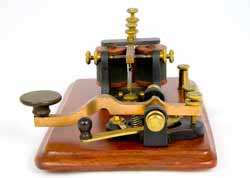
This one dates from between 1850 and 1860. It has no adjustment on the spring and therefore dates from before 1860. Note the "hump" in its back that gives it the name.
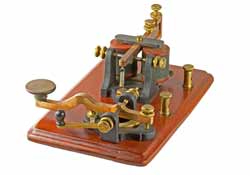
On the second view of the Camelback key, the sounder can be seen behind the Morse key itself. Often US telegraph operators would move from one place to another as the work arose. They would take their keys with them that included a sounder. As a result these combinations became known as a "Key-on-Base" or KOB for short.
Steel lever keys
Morse keys continued to be used in ever-increasing numbers and their development progressed. The next major step forward occurred when James Bunnell introduced his "Triumph Key" in 1881. The basic design involved a steel lever with an integral trunnion or fulcrum. A hollow oval frame made the key very light and easy to use.
These steel lever keys provided a number of advantages. Early keys suffered from the fact that the lever would come loose from the press fit trunnion. As a result of the improvements this style of key was produced in large quantities by a number of companies including Western Electric, Signal Electric and of course the Bunnell company itself.
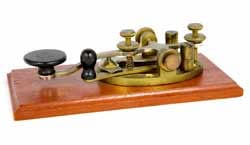
This one was manufactured around 1920 but it follows the basic design introduced by James Bunnell in 1881.
Other keys
The steel level key was not the only format that was manufactured. Particularly within Europe the keys were heavier as they were not moved from one place to another in quite the same way as they were in the US.
A typical example of the European style of key was the British Post Office Morse key.

European keys often tended to be heavier than their US counterparts. This British Post office key dates from around 1900 and was manufactured by Walters Electrical.
Other Morse keys were also manufactured in various parts of the globe, especially in areas where telegraph lines were key to communications. One such area was in Australia.
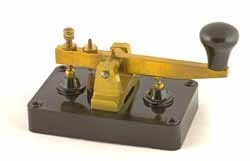
Morse keys for special applications
A number of Morse keys were developed to fulfil special applications. These were often not produced in such large quantities, although some were.
In the early days of wireless or radio communications, it was not possible to key low voltage lines to control much higher voltage lines. Instead it was necessary to directly key the high voltage lines. These keys often had insulators to prevent breakdown between the contacts, and as a result of the very high voltages around, they must have been quite dangerous to use.
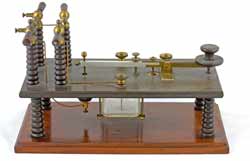
Despite the danger, these keys were successfully used for many early radio communications systems.
Military Morse keys
Good communications is an essential requirements for any military force. Not surprisingly, the Morse code was widely used for military applications. It was widely used in the American civil war and then for conflicts afterwards.
As a result, Morse code and Morse keys were widely used in World War 2, especially for radio communications, and a whole variety of keys were used.
One form of Morse key that is widely available is the British WT 8 Amp key. This was manufactured by a number of different companies and the actual keys may differ in overall appearance although they conform to the same general overall outline.
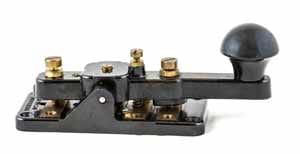

One notable key was what is often termed the RAF 'Bathtub' key. This was developed for operation in World War II RAF bombers such as the British Avro Lancaster and many others. The key was developed to be used in environments where it was feared fuel fumes could cause explosions and therefore it is totally enclosed. The mechanism is attached to the top of the key and operates upside down. It also had a feature whereby the cover clip could be pulled up over the skirt of the knob on the key to keep it down and thereby making continuous contact for a continuous transmission. This could aid rescue if the aircraft was downed and the transmitter was still operational.
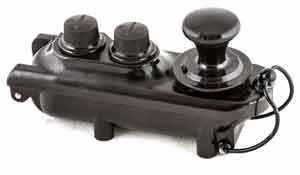
This key was often used with the T1154 transmitter and R1155 receiver combination. Thus the key was widely sued for radio communications and it is likely that this form of key as used to send the messages back from raids such as the famous "Dambusters" raid over Nazi Germany.
Sideswipers
Despite these improvements difficulties were still being experienced. Operators were working very long hours and suffering from wrist pains. These were known as telegraphers cramp, or paralysis, and this arose from the large number of movements that needed to be made. Today this would be known as repetitive strain injury, RSI.
To help overcome this Bunnell introduced a new form of key in 1888 known as the sideswiper. Instead of using an up and down action the sideswiper used a side to side action with contact being made when the key was moved to either side. A rest or off position was in the centre.
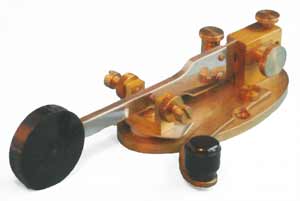
Note the different type of construction with the paddle
Mechanical bug keys
The sideswiper was a great improvement for telegraphers. The incidence of telegraphers cramp reduced significantly. The next step in the development of keys was the semi-automatic or "bug" key. The first major step in the automation of Morse generation appeared in 1902 when Charles Yetman received his patent for what he called a telegraphic transmitter. This consisted of a typerwriter keyboard that converted the key depressions into Morse characters. The idea did not catch on because the unit was large and expensive.
A year later Horace Martin introduced a machine called an Autoplex. This was battery powered and had a vibrating arm to generate the dots. Production of these items was very slow and only continued until 1905. However in 1904 Martin introduced a mechanical bug in 1904 he called a Vibroplex. It used a vibrating arm to generate the dots. Martin filed the patent for his idea on 7 May 1904, but he was not the only person working along these lines. A man named William Coffe filed a patent on 11 January 1904. This was very general in its wording encompassing many aspects of keyers, and as a result it was granted after that of Martin's. As a result many legal battles were fought. The Vibroplex bug key was very successful and can still be bought today.
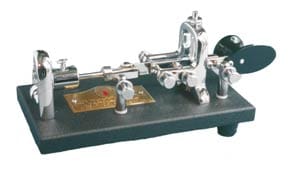
With the advancement of electronics, fully automatic keyers that generated dots and dashes were eventually produced. Some of the earliest designs date from the 1940s.
Electronic keyers, often called "el-bugs" or electronic bug keys became widespread in their use.
Electronic el-bug keyers
Now with the introduction of integrated circuit technology electronic keyers capable of generating both dots and dashes. This further improved the speed at which Morse could be sent along with improving the style as all dots and dashes would be of the correct length.
These keyers were also capable of storing strings of code and this enabled pre-programmed messages to be sent at the press of a single button.
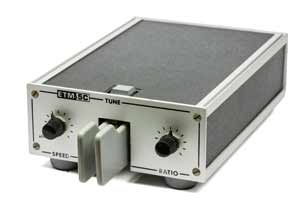
The electronics for these keyers was often incorporated into a radio transmitter or transceiver and this meant that only the 'paddle' itself was required.
Computer technology was also employed, being able to send messages type in on a keyboard or stored. Programmes were also developed to read Morse code as well. Although these programmes could typically not read signals as far into the noise or in the presence of interference as well as experienced human operators, but they were nevertheless still impressive.
Morse key history infographic
It can be useful to have a summary infographic detailing some of the highlights of Morse key development.
It's impossible to detail everything so I've made a selection of some of my favourites and the ones I feel are important.
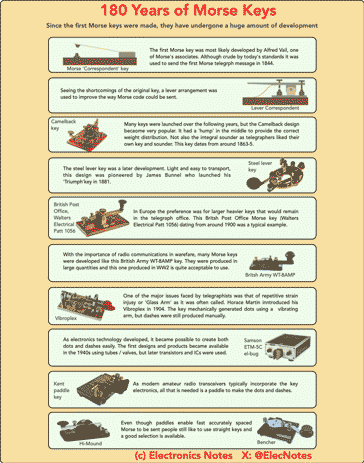
Click on image for larger version
This is only a short summary of the developments that occurred with Morse keys, and naturally many interesting facts and keys have had to be omitted because of space.
 Written by Ian Poole .
Written by Ian Poole .
Experienced electronics engineer and author.
More History:
Radio history timeline
History of the radio
Ham radio history
Coherer
Crystal radio
Magnetic detector
Spark transmitter
Morse telegraph
Valve / tube history
PN junction diode invention
Transistor
Integrated circuit
Quartz crystals
Classic radios
Mobile telecoms history
Vintage mobile phones
Return to History menu . . .




